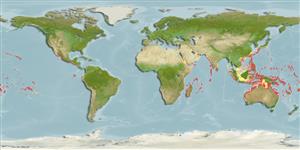Classification / Names
Common names from other countries
Main reference
Size / Weight / Age
Max length : 14.0 cm TL male/unsexed; (Ref. 2798)
Environment
Marine; reef-associated; depth range 5 - 46 m (Ref. 1602), usually 5 - 15 m (Ref. 27115)
Climate / Range
Tropical; 22°C - 27°C (Ref. 27115), preferred ?; 35°N - 35°S
Distribution
Indo-Pacific: Red Sea and East Africa to the Hawaiian, Line, Marquesas, and Society Islands, north to the Ryukyu Islands, south to Lord Howe Island; Mariana, Caroline, and Marshall Islands in Micronesia.
Countries | FAO areas | Ecosystems | Occurrences | Introductions
Short description
Dorsal
spines
(total): 7;
Dorsal
soft rays
(total): 29-33;
Anal
spines: 1;
Anal
soft rays: 27 - 30;
Vertebrae: 26. Light blue to pale bluish gray; upper edge of operculum with a longitudinal iridescent blue band divided into 2 sections. Caudal fin yellowish, some with an orangish streak passing anteriorly from spot; 1st dorsal fin not as high as the 2nd; 2nd dorsal and anal fins not elevated anteriorly; pelvic fins not long; base of pectoral fin usually with a blue-edged salmon-pink spot.
IUCN Red List Status (Ref. 115185)
Threat to humans
Harmless
Human uses
Aquarium: commercial
More information
ReferencesAquacultureAquaculture profileStrainsGeneticsAllele frequenciesHeritabilityDiseasesProcessingMass conversion
Tools
Special reports
Download XML
Internet sources
Estimates of some properties based on models
Phylogenetic diversity index
PD50 = 0.5000 many relatives (e.g. carps) 0.5 - 2.0 few relatives (e.g. lungfishes)
Trophic Level
3.4 ±0.45 se; Based on food items.
Resilience
Vulnerability
Low vulnerability (10 of 100)
Price category
